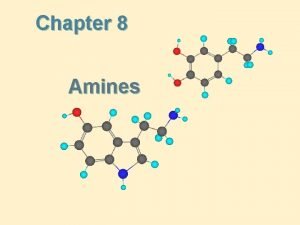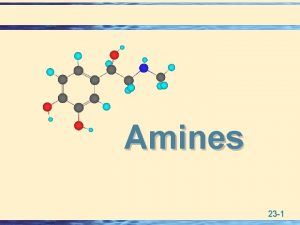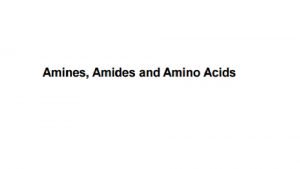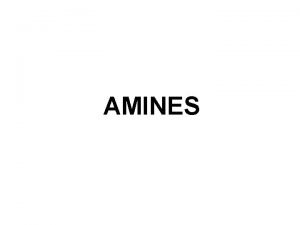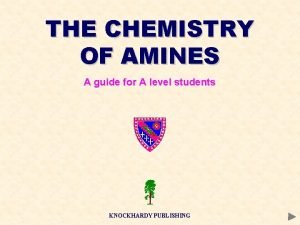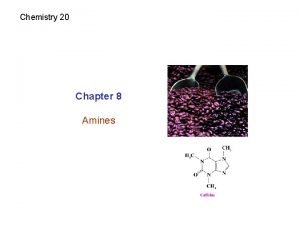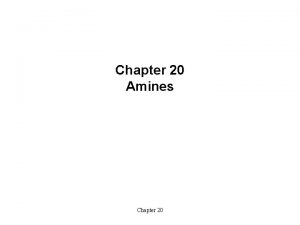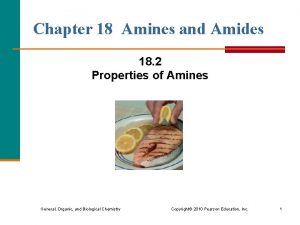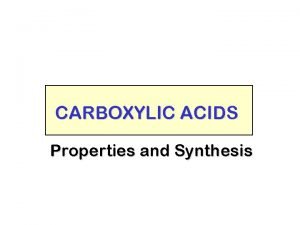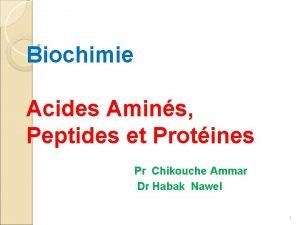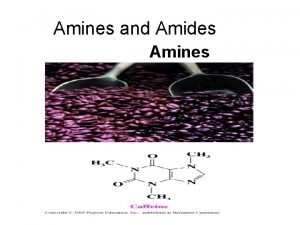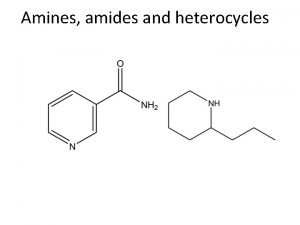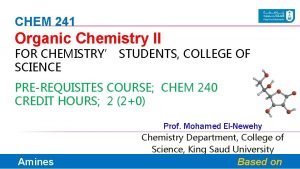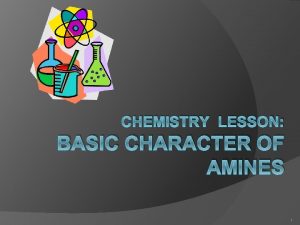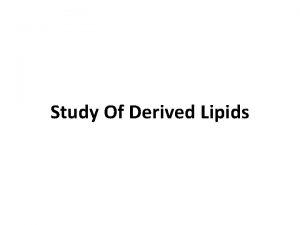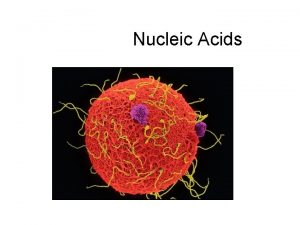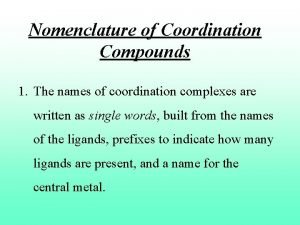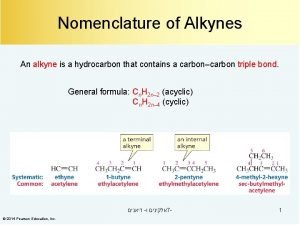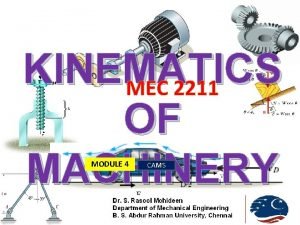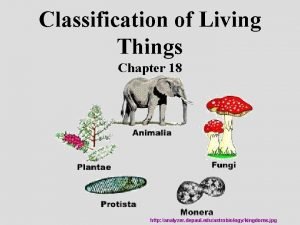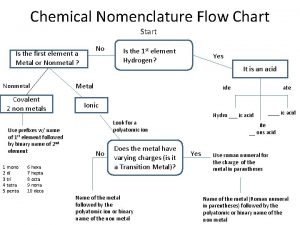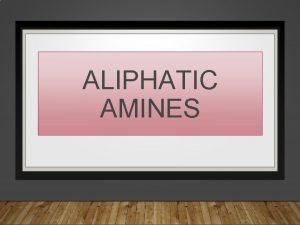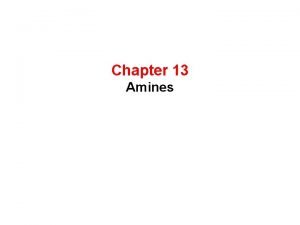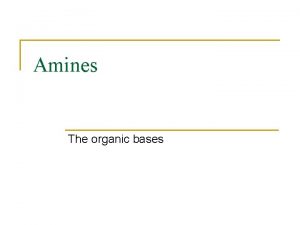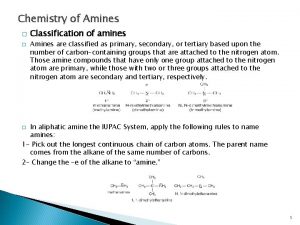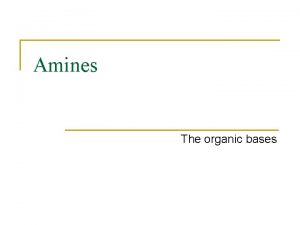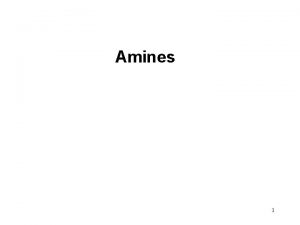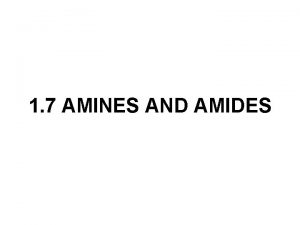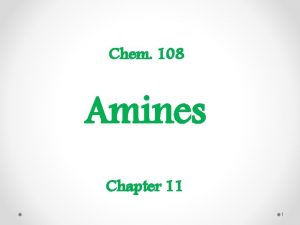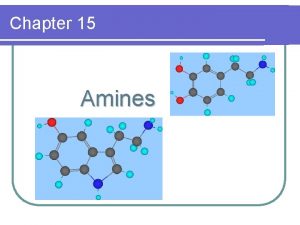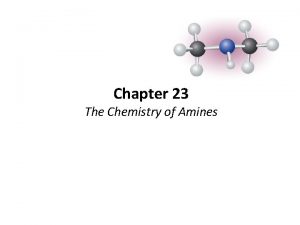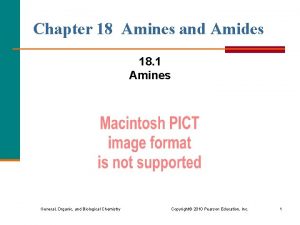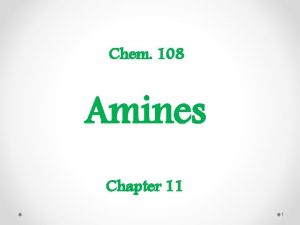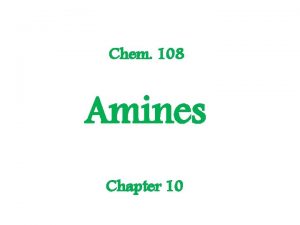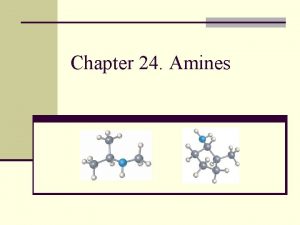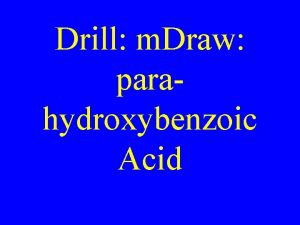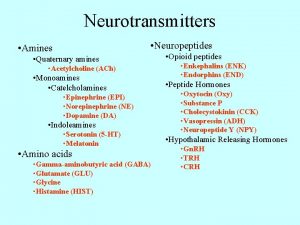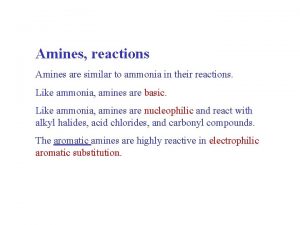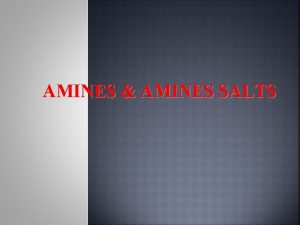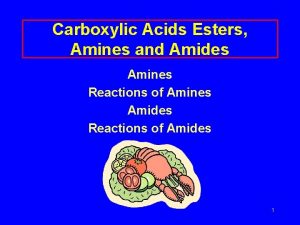Chapter 20 Amines Chapter 20 t Nomenclature Primary
















































- Slides: 48

Chapter 20 Amines Chapter 20

t Nomenclature èPrimary amines are named in systematic (IUPAC) nomenclature by replacing the -e of the corresponding parent alkane with -amine èIn common nomenclature they are named as alkylamines èSimple secondary and tertiary amines are named in common nomenclature by designating the organic groups separately in front of the word amine èIn systematic nomenclature, the smaller groups on the amine nitrogen are designated as substituents and given the locant N Chapter 20 2

èIn IUPAC nomenclature the substitutent -NH 2 is called the amino group l Aryl Amines èThe common arylamines have the following names: Chapter 20 3

l Heterocyclic Amines èThe important heterocylcic amines have common names èIn IUPAC nomenclature the prefixes aza-, diaza- and triaza- are used to indicate that nitrogen has replaced carbon in the corresponding hydrocarbon H The nitrogen is assigned position 1 and the ring is numbered to give the lowest overall set of locants to the heteroatoms Chapter 20 4

t Physical Properties and Structure of Amines èPrimary and secondary amines can form hydrogen bonds to each other and water èTertiary amines cannot form hydrogen bonds to each other but can form hydrogen bonds to hydrogen bond donors such as water èTertiary amines have lower boiling points than primary or secondary amines of comparable molecular weights èLow molecular weight amines tend to be water soluble whether they are primary, secondary or tertiary Chapter 20 5

Chapter 20 6

t Structure of Amines èThe nitrogen atom in an amine is sp 3 hybridized The three groups and the unshared electron pair around nitrogen result in a tetrahedral geometry H If only the location of the groups (and not the unshared electron pair) are considered, the shape of the amine is trigonal pyramidal H Partial negative charge is localized in the region of the nonbonding electrons H èIt is usually impossible to resolve amine enantiomers that are chiral at nitrogen because they interconvert rapidly H The interconversion occurs through a pyramidal or nitrogen inversion involving the unshared electron pair Chapter 20 7

èQuaternary ammonium salts can be resolved into enantiomers H Chiral quaternary ammonium salts cannot undergo nitrogen inversion because they lack an unshared electron pair on the nitrogen atom Chapter 20 8

t Basicity of Amines: Amine Salts èAmines are weak bases èRelative basicity of amines can be compared in terms of p. Ka values for their respective conjugate acids H The more basic the amine, the higher the p. Ka of its conjugate acid will be èPrimary alkyl amines are more basic than ammonia H An alkyl group helps to stabilize the alkylaminium ion resulting from protonation of the amine Chapter 20 9

èIn the gas phase, basicity in the family of methylamines increases with increasing methyl substitution H More alkyl substitution results in more stabilization of the alkylaminium ion èIn aqueous solution, trimethylamine is less basic than dimethyl- or methylamine An alkylaminium ion in water is solvated and stabilized by hydrogen bonding of its hydrogens with water H The trimethylaminium ion has only one hydrogen with which to hydrogen bond to water H The trimethylaminium ion is solvated less well (and therefore stabilized less) than the dimethylaminium ion, which has two hydrogen atoms for hydrogen bonding H Chapter 20 10

l Basicity of Arylamines èArylamines are weaker bases than the corresponding nonaromatic cyclohexylamines èThe unshared electron pair on nitrogen of an arylamine is delocalized to the ortho and para positions of the ring H The lone pair is less available for protonation, i. e. , it is less basic èProtonation of aniline is also disfavored because a protonated arylamine has only two resonance forms H Anilinium ion is not as well stabilized by resonance as aniline itself Chapter 20 11

èDHo for protonation of aniline is larger than DHo for protonation of cyclohexyl amine H Greater resonance stabilization of aniline relative to anilinium ion accounts for the larger DHo for protonation, as compared with DHo for protonation of an amine that is not aromatic Chapter 20 12

l Basicity of Heterocyclic Amines èNonaromatic heterocyclic amines have approximately the same basicity as their acyclic counterparts èAromatic heterocyclic amines (in aqueous solution) are much weaker bases than nonaromatic amines Chapter 20 13

l Amines versus Amides èAmides are much less basic than amines H The p. Ka of a protonated amide is typically about zero èOne reason for this much lower basicity is that the amide is greatly stabilized by resonance but the protonated amide is not èA more important reason for the weaker basicity of amides is that the nitrogen lone pair is delocalized to the carbonyl oxygen Amides are actually protonated at the oxygen atom H Protonation at the oxygen allows resonance stabilization of the positive charge H Chapter 20 14

l Aminium Salts and Quaternary Ammonium Salts èProtonation of amines with acids leads to formation of aminium salts H Aminium salts are formed from 1 o, 2 o or 3 o amines and the aminium ion bears at least one hydrogen èQuaternary ammonium salts have four groups on the nitrogen H The nitrogen atom is positively charged but does not bear a hydrogen atom Chapter 20 15

èQuaternary ammonium halides are not basic because they do not have an unshared electron pair on nitrogen èQuaternary ammonium hydroxides are very basic because they contain the very strong base hydroxide Chapter 20 16

l Solubility of Amines in Aqueous Acid èMany aminium chlorides, bromides, iodides and sulfates are water soluble H Amines which are not soluble in water will often dissolve in dilute aqueous acid èSolubility of amines in dilute acid can be used as a chemical test to distinguish amines from compounds that are not basic èWater-insoluble amines can be separated from water-insoluble neutral or acidic compounds by virtue of the amine’s solubility in aqueous acid The amine is extracted into aqueous acid H The amine is recovered by making the solution basic and extracting the amine into an organic solvent H èAmides are not basic and are not soluble in aqueous acids Chapter 20 17

l Amines as Resolving Agents èA chiral amine can be used to resolve a racemic mixture of carboxylic acids by formation of diastereomeric salts Diastereomers can be separated on the basis of differences in physical properties H Acidification of the separated diastereomeric salts gives the resolved carboxylic acids H Chapter 20 18

t Preparation of Amines l By Nucleophilic Substitution Reactions èAlkylation of Ammonia Reaction of ammonia with an alkyl halide leads to an aminium salt H The salt is treated with base to give the primary amine H The method is limited because multiple alkylations usually occur H H Using an excess of ammonia helps to minimize multiple alkylations Chapter 20 19

èAlkylation of Azide Ion followed by Reduction H A primary amine is prepared more efficiently by reaction of azide anion with an alkyl halide and subsequent reduction of the alkylazide to the amine èThe Gabriel Synthesis Primary amines can also be made cleanly by the Gabriel Synthesis H The first step in the Gabriel synthesis is alkylation of potassium phthalimide H Reaction of the N-alkylphthalimide with hydrazine in boiling ethanol gives the primary amine H Chapter 20 20

l Preparation of Aromatic Amines by Reduction of Nitro Compounds èAromatic amines can be synthesized by reduction of the corresponding nitro compound èOne molar equivalent of hydrogen sulfide in alcoholic ammonia can be used to reduce one nitro group in the presence of another Chapter 20 21

l Preparation of Primary, Secondary and Tertiary Amines through Reductive Amination èAldehydes and ketones react with ammonia, primary or secondary amines to yield imines or iminium ions H The imines and iminium ions can then be reduced to new primary, secondary or tertiary amines, respectively Chapter 20 22

èThe reduction can be accomplished using catalytic hydrogenation or a hydride reducing reagent H Na. BH 3 CN and Li. BH 3 CN are especially effective in reductive aminations Chapter 20 23

l Preparation of Primary, Secondary, or Tertiary Amines through Reduction of Nitriles, Oximes, and Amides èReduction of nitriles or oximes yield primary amines èReduction of amides can yield primary, secondary or tertiary amines Chapter 20 24

èReduction can be accomplished by using catalytic hydrogenation or Li. Al. H 4 èMonoalkylation of an amine can be achieved by acylation of the amine and then reduction of the resulting amide Chapter 20 25

l Preparation of Primary Amines by the Hofmann and Curtius Rearrangements èAn unsubstituted amide can be converted to a primary amine by formal loss of the amide carbonyl through the Hofmann rearrangement (also called the Hofmann degradation) èThe first two steps of the mechanism result in N-bromination of the amide The N-bromoamide is deprotonated and rearranges to an isocyanate H The isocyanate is hydrolyzed to a carbamate which decarboxylates to the amine H Chapter 20 26

Chapter 20 27

èThe Curtius rearrangement occurs through the intermediacy of an acyl azide The acyl azide is obtained from an acid chloride H Rearrangement of the acyl azide occurs with loss of N 2, a very stable leaving group H In the last step, the isocyanate is hydrolyzed by adding water H Chapter 20 28

t Reactions of Amines èThe lone pair of the amine nitrogen atom accounts for most chemistry of amines H The unshared electron pair can act as a base or as a nucleophile èThe nitrogen lone pair can also make a carbon nucleophilic by resonance Chapter 20 29

l Oxidation of Amines èPrimary and secondary amines undergo N-oxidation, but useful products are not obtained because of side-reactions èTertiary amines undergo clean N-oxidation Chapter 20 30

t Reactions of Amines with Nitrous Acid èNitrous acid (HONO) is prepared in situ by reaction of sodium nitrite with a strong aqueous acid l Reaction of Primary Aliphatic Amines with Nitrous Acid èPrimary amines undergo diazotization with nitrous acid The unstable diazonium salts decompose to form carbocations H The carbocations react further to give alkenes, alcohols and alkyl halides H Chapter 20 31

l Reaction of Primary Arylamines with Nitrous Acid èReaction of primary arylamines with nitrous acid results in the formation of relatively stable arenediazonium salts This reaction occurs through the intermediacy of an N-nitrosoamine H The N-nitrosoamine is converted to a diazonium ion in a series of steps H Chapter 20 32

t Replacement Reactions of Arenediazonium Salts èAryldiazonium salts react readily with various nucleophilic reagents to give a wide variety of aromatic compounds The aryldiazonium salt is made from the corresponding arylamine H The arylamine can be made by reduction of a nitroaromatic compound H Chapter 20 33

l The Sandmeyer Reaction: Replacement of the Diazonium Group by -Cl, -Br or -CN èThe mechanism of the Sandmeyer reaction is not well-understood but is thought to occur via radicals Chapter 20 34

l Replacement by -I èReaction of arenediazonium salts with potassium iodide gives the aryliodide l Replacement by -F èA diazonium fluoroborate is isolated, dried and heated until it decomposes to the fluoroaromatic product Chapter 20 35

l Replacement by -OH èAn aryl diazonium salt is placed in aqueous solution with a large excess of cupric nitrate and then treated with cuprous oxide Chapter 20 36

l Replacement by Hydrogen: Deamination by Diazotization èAn arenediazonium salt can react with hypophosphorous acid (H 3 PO 2) to replace the diazonium group with a hydrogen atom H This reaction can be used to remove an amino group that was important early in a synthesis as an ortho, para director èExample: m-Bromotoluene cannot be made directly from either toluene or bromobenzene H N-acetylation is used to reduce the activating effect of the amine Chapter 20 37

t Coupling Reactions of Arenediazonium Salts èArenediazonium ions react as electrophiles with highly reactive aromatic compounds such as phenol and aromatic tertiary amines H The reaction is called a diazo coupling reaction èCoupling with phenol occurs best in slightly alkaline solution The alkaline solution produces a phenoxide ion that couples more rapidly H If the solution is too alkaline, a nonreactive diazohydroxide is produced H Chapter 20 38

èPhenol and aniline derivatives undergo coupling almost exclusively at the para position unless this position is blocked èAzo compounds are commonly used as dyes The azo coupling results in compounds which are highly conjugated and which often absorb light in the visible region H The -SO 3 -Na+ group is added to the molecule to confer water solubility and to link the dye to the polar fibers of wool, cotton etc. H Orange II is made from 2 -naphthol H Chapter 20 39

t Reactions of Amines with Sulfonyl Chlorides èPrimary and secondary amines react with sulfonyl chlorides to produce sulfonamides H A sulfonamide can be hydrolyzed to an amine by heating with aqueous acid Chapter 20 40

l The Hinsberg Test èThis test can distinguish between 1 o, 2 o and 3 o amines èAn amine and benzenesulfonyl chloride are mixed with aqueous potassium hydroxide; the reaction is acidified in a second step H The results are different depending on the class of amine èA benzenesulfonamide from a primary amine is soluble in basic solution, but precipitates upon acidification Chapter 20 41

èA secondary amine forms a precipitate directly because an N, Ndisubstituted sulfonamide remains insoluble in basic solution H There is no acidic hydrogen in an N, N-disubstituted sulfonamide èA tertiary amine will not react to form a sulfonamide, but will dissolve upon acidification H Acidification converts the amine to a water soluble iminium salt Chapter 20 42

t Analysis of Amines l Chemical Analysis èAmines can generally be distinguished by their ability to dissolve in dilute aqueous acid èWet litmus paper will indicate the basicity of an amine èThe Hinsberg test can be use to distinguish among primary, secondary and tertiary amines Chapter 20 43

l Spectroscopic Analysis èInfrared Spectra Primary and secondary amines are characterized by N-H stretching vibrations in the 3300 -3555 cm -1 region H Primary amines give 2 absorptions (from symmetric and asymmetric stretching); secondary amines give one absorption H è 1 H NMR Primary and secondary amines have broad, uncoupled N-H peaks at d 0. 5 -5 H N-H protons will exchange with D 2 O and disappear from the 1 H spectrum H Protons on carbons adjacent to the nitrogen appear at d 2. 2 -2. 9 H Chapter 20 44

è 13 C NMR Spectra Carbons bonded to nitrogen exhibit 13 C signals not as far downfield (d 20 -70) as carbons bonded to oxygen (d 40 -80) due to the lesser electronegativity of nitrogen as compared to oxygen H The deshielding effect of the nitrogen atom decreases with distance H Chapter 20 45

t Eliminations Involving Ammonium Compounds l The Hofmann Elimination èAn E 2 -type reaction occurs when a quaternary ammonium hydroxide is heated H An amine is a relatively good leaving group èA quaternary ammonium hydroxide can be made from a quaternary ammonium halide using silver oxide Chapter 20 46

èHofmann elimination and other elimination reactions of charged substrates proceed to give the least substituted double bond H This is called the Hofmann rule, and the least substituted alkene product is called the Hofmann product Chapter 20 47

l The Cope Elimination èA tertiary amine oxide will undergo elimination to the alkene when heated èTertiary amine oxides can be made from tertiary amines by reaction with hydrogen peroxide H Amine oxide elimination is syn and proceeds via a cyclic transition state Chapter 20 48
 Aliphatic amines
Aliphatic amines Basicity of amines
Basicity of amines Guanidine basicity
Guanidine basicity Prinary amine
Prinary amine Primary, secondary tertiary amine
Primary, secondary tertiary amine Vital plus amine
Vital plus amine Physical properties of amines
Physical properties of amines Les polyacides
Les polyacides Les drogues vasoactives
Les drogues vasoactives Naming amine
Naming amine Amm chapter 20
Amm chapter 20 Amines hydrogen bonding
Amines hydrogen bonding Acid naming
Acid naming Chromotagraphie
Chromotagraphie O ch
O ch Are amines water soluble
Are amines water soluble Solubility of amines
Solubility of amines Basicity amines
Basicity amines Do aromatic amines give hinsberg test
Do aromatic amines give hinsberg test Aniline reacts with bromine water at room temperature
Aniline reacts with bromine water at room temperature Basic character of amines
Basic character of amines Chronotropic
Chronotropic Magenta cyan and yellow are the ____ color. *
Magenta cyan and yellow are the ____ color. * Taser 7 nomenclature
Taser 7 nomenclature Nomenclature of bolts
Nomenclature of bolts Profile milling
Profile milling Basic organic nomenclature packet
Basic organic nomenclature packet Molecular structure of saturated fat
Molecular structure of saturated fat Spring nomenclature
Spring nomenclature Simple key loader battery
Simple key loader battery Wire rope nomenclature
Wire rope nomenclature Remington 870 shotgun nomenclature
Remington 870 shotgun nomenclature Naming organic compounds
Naming organic compounds Nucleotide nomenclature
Nucleotide nomenclature Nucleotide nomenclature
Nucleotide nomenclature Coordination compound nomenclature
Coordination compound nomenclature Triple bond nomenclature
Triple bond nomenclature How to name ester
How to name ester End mill nomenclature
End mill nomenclature Up milling and down milling
Up milling and down milling échelle 3 plans pompier nomenclature
échelle 3 plans pompier nomenclature A radial follower is one
A radial follower is one Todays objective
Todays objective Nomenclature poteau incendie
Nomenclature poteau incendie Diode nomenclature
Diode nomenclature Rules of binomial nomenclature
Rules of binomial nomenclature Kids prefer cheese over fried green spinach
Kids prefer cheese over fried green spinach Autotrophic plants examples with names
Autotrophic plants examples with names Chemical nomenclature chart
Chemical nomenclature chart

